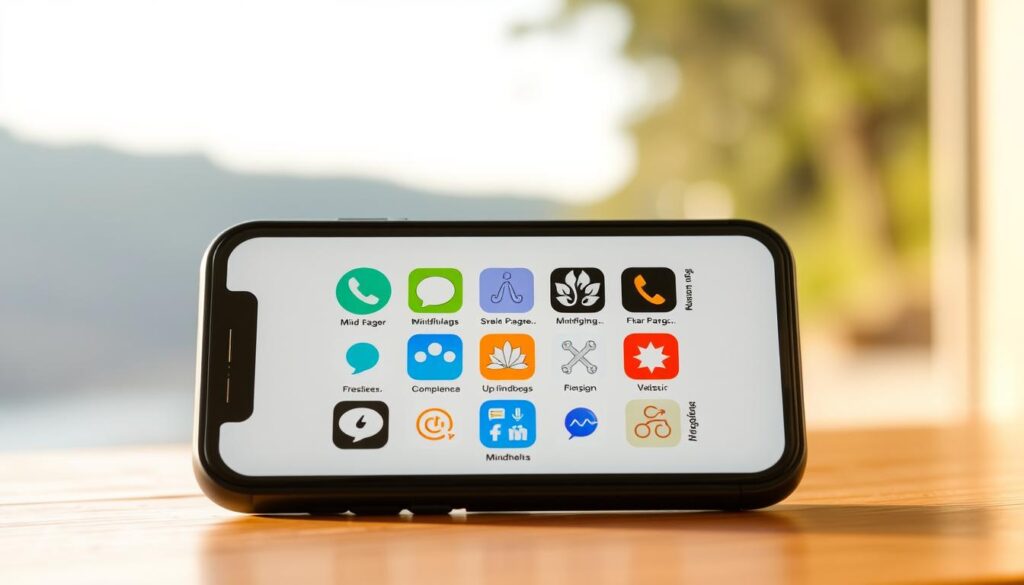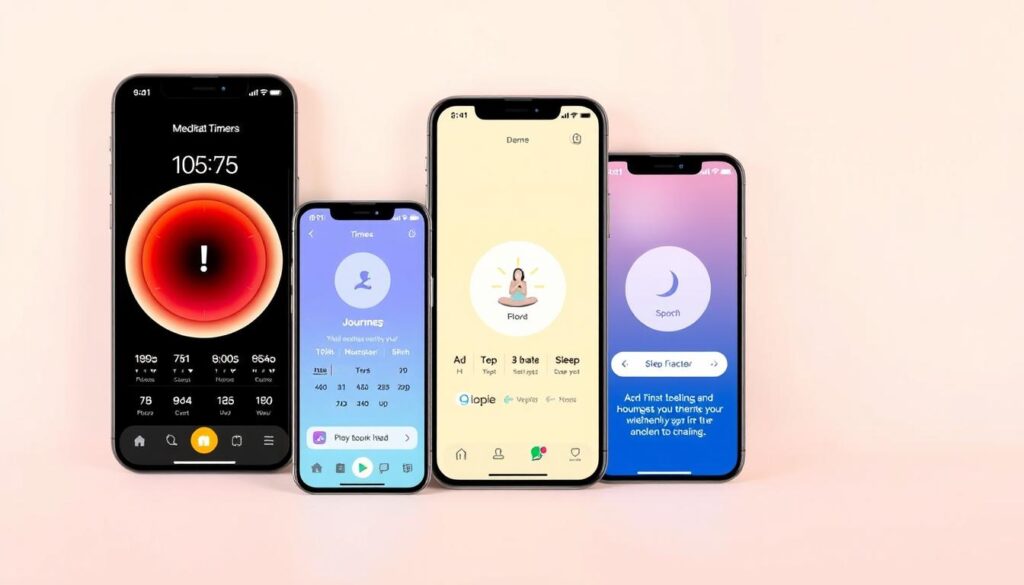Discover the Top Mindfulness Apps for Your Daily Practice

Imagine you’re dealing with deadlines, family, and endless tasks. But you long for calm moments. Good news: you don’t need hours of meditation or a quiet spot. Mindfulness apps for daily use are turning phones into peace tools.
Millions in the U.S. use them to cut stress, improve focus, and boost mental strength. These apps offer routines that fit your life, not the other way around.
Imagine a five-minute breathwork session with your morning coffee. Or a quick gratitude exercise before bed. These small steps make a big difference.
Apps like Calm and Headspace help you take control, even on busy days. Let’s see how these tools can make mindfulness a part of your daily routine, as easy as brushing your teeth.
Key Takeaways
- Mindfulness apps for daily practice offer guided sessions tailored to busy schedules.
- Apps like Insight Timer provide free resources to start, with premium options for deeper learning.
- Tracking progress builds motivation, showing how small daily efforts improve mental health over time.
- These tools simplify mindfulness, making it accessible even for beginners.
- Thousands of users report reduced stress and better focus within weeks of consistent use.
What is Mindfulness and Why is it Important?
Mindfulness is more than just a trend—it’s a skill you can learn. It’s about focusing on the present moment. You notice your breath, sounds, or body sensations without judgment.
Understanding Mindfulness Concepts
Key concepts include:
- Present-moment awareness: Focusing on what’s happening right now.
- Non-judgmental observation: Observing thoughts and feelings without labeling them good or bad.
- Intentional attention: Choosing to direct your focus, like during mindfulness exercises that guide your breathing or body scans.
Benefits of Regular Mindfulness Practice
“Mindfulness isn’t about emptying the mind. It’s about training attention.”
Science shows practicing mindfulness techniques can:
- Reduce stress and anxiety levels by up to 30% (studies show).
- Boost emotional resilience and improve sleep quality.
- Lower blood pressure and support clearer thinking.
Even 10 minutes of daily practice can make a difference. Apps often turn these principles into guided sessions, making it easier to start. Ready to try? Let’s explore how to pick the right tools next.
Characteristics of Effective Mindfulness Apps
Choosing the right mindfulness tools starts with knowing what makes an app stand out. Let’s break down three must-have features in apps that truly support your practice.
User-Friendly Design
Effective apps prioritize simplicity. Look for clean layouts and intuitive navigation. Customizable timers, clear menu options, and one-tap access to favorite sessions make mindfulness a breeze. Apps like Calm use bold icons and voice-guided tutorials to help beginners feel at ease.
Variety of Practices Offered
Flexibility matters. Top apps include guided meditations, breathing exercises, and body scans. For instance, Insight Timer offers thousands of free sessions on topics like stress relief or sleep aids. Diverse options keep your routine fresh and match evolving needs.
Progress Tracking Features
Seeing your growth fuels motivation. Streak counters, session length logs, and mood journals turn practice into a measurable journey. The Headspace app tracks meditation minutes and rewards consistency with badges. Visual graphs show progress over weeks, helping you celebrate milestones.
“Tracking small wins builds confidence.” – Mindfulness user study, 2023
These features ensure your app adapts to you, not the other way around. Prioritize apps that blend ease of use, diversity, and clear feedback to keep your mindfulness journey on track.
Top Mindfulness Apps for Daily Use
Ready to dive into mindfulness? Here’s a closer look at three standout meditation apps designed to fit your routine:
Headspace: Guided Meditation for Everyone
Headspace uses animated guides and structured courses to simplify mindfulness. It offers programs for stress, focus, and sleep, plus short sessions for busy days. Free trials let you test guided exercises before committing to a subscription.
Calm: Sleep and Relaxation Focus
Calm shines with its sleep stories and nature sounds. The Daily Calm session provides fresh 10-minute meditations daily. Its celebrity-narrated bedtime stories and breathing programs make it ideal for those prioritizing rest.
Insight Timer: Community and Free Resources
Access 30,000+ free meditations on Insight Timer, plus live events and a global community. Premium features add courses from top teachers, but the free tier is robust for beginners. Great for social learners.
| Feature | Headspace | Calm | Insight Timer |
|---|---|---|---|
| Free Content | Limited | Basic access | Full library |
| Sleep Tools | Guided sessions | Stories + soundscapes | Nature sounds |
| Cost | $12.99/month | $19.99/month | Free + $12.99/month premium |
Pick what aligns with your goals: structured learning, sleep aids, or community support. Each meditation app offers unique tools to make mindfulness accessible. Explore which fits your lifestyle best.
How to Choose the Right Mindfulness App
Choosing the right mindfulness practice app starts with knowing what you need. Everyone’s journey to mindfulness is unique. Your app should match your goals and lifestyle. Here’s how to pick the best one.
Assessing Your Personal Goals
First, think about what you want to achieve. Do you want to reduce stress, sleep better, or focus more? Apps vary in what they offer. Some are great for anxiety, while others help with relaxation.
Read what each app says to see if it fits your goals.
- Ask yourself: What’s my top goal? Stress relief? Sleep? Clarity?
- Explore features: Does the app offer sessions tailored to your objectives?

“Your mindfulness practice app should feel like a natural fit for your life, not an extra chore.” — Mindfulness experts
Considering Your Lifestyle and Schedule
Then, think about how the app fits into your daily life. If you’re always busy, look for short sessions. If you have more time, choose longer ones. It’s important to have flexibility.
Does the app let you use it offline? Can you change the length of your sessions?
- Time constraints? Choose apps with 5- or 10-minute options.
- Flexible schedule? Prioritize apps with extended sessions and customizable tracks.
There’s no one app for everyone. Trust your gut. Your perfect mindfulness practice app will support you without feeling like a burden.
Pricing Models of Mindfulness Apps
Choosing a mindful living app means finding a balance between quality and cost. Let’s explore how pricing works and what you get for your money.
Free vs. Premium Features
Most apps have free versions with basic features like meditation and tracking. But, premium tiers offer more: Headspace and Calm give full access to their libraries, offline use, and no ads for subscribers. Free versions often have shorter sessions or less content.
- Free access: Limited guided sessions, basic progress tracking
- Premium perks: Exclusive content, personalized plans, no ads
Subscription Costs and Value
Annual subscriptions cost $60–$130, while monthly plans are $12–$18. These costs are much less than gym memberships or therapy. Many apps offer family plans (up to 5 users) or lifetime purchases for savings.
“Investing in a mindful living app is like paying for preventive care for your mind.”
Look for discounts, student offers, or free trials. Some apps give extra content for yearly commitments. Ask yourself: does the price match the benefits you need?
Mindfulness App Features to Look For
Choosing the right self-care app means finding tools that fit your needs. Here’s what to look for:

Customizable Meditations
Good self-care apps let you customize sessions. Look for options to:
- Adjust meditation lengths from 3 to 30+ minutes
- Select ambient sounds like rainforest or ocean waves
- Choose between guided or silent focus modes
- Set reminders for specific mental focus areas (anxiety, gratitude, sleep)
Community Support and Interaction
Top apps like Insight Timer offer:
- Live group meditations with certified instructors
- Private forums for sharing progress and challenges
- Achievement badges for consistent practice
“Community features increase practice consistency by 40%” – Mindful Living 2023 Report
Offline Accessibility
Compare leading apps’ offline features:
| Feature | Headspace | Calm | Insight Timer |
|---|---|---|---|
| Offline downloads | Yes (Premium) | Yes (Premium) | Free + Premium |
| Storage limits | 50 sessions max | Unlimited | Customizable |
| Download speed | 30 seconds/session | 15 seconds/session | 10 seconds/session |
Make sure your self-care app works well when you travel. 85% of users say offline access is key for staying consistent.
Integrating Mindfulness Apps into Your Routine
Starting mindfulness as a habit is about small, consistent steps. Mindfulness apps help you create routines that last. Let’s see how to make these practices a part of your day.
Setting Daily Reminders
Apps like Headspace or Calm let you set reminders that don’t get in the way. Here are some tips:
- Choose soft notifications, like a gentle chime instead of a buzz.
- Use personalized messages, like “Take 5 minutes to breathe,” to keep you going.
- Start with reminders once a day and increase as you get used to it.
Finding the Best Time for Practice
Try different times to find what works best for you:
- Mornings: Start your day with a guided meditation for clarity.
- Lunch Breaks: A 10-minute session on Insight Timer can refresh you.
- Evenings: Sunset sessions can help you unwind and reflect.
- Bedtime: Many apps offer sleep exercises to calm your mind before bed.
Being flexible is important. If a time doesn’t work, try another. The goal is to make mindfulness feel natural, not forced. Your routine is unique—let these apps fit into your life, not the other way around.
Enhancing Your Mindfulness Practice with Additional Tools
Expanding your mindfulness journey doesn’t mean you need a lot of apps. Using a main mindfulness tool with other mental wellness tools can boost focus, clarity, and calm. These tools together create a system that fits your needs perfectly.
Combining the right tools helps turn fleeting moments of calm into lasting habits.
Journaling and Reflection Apps
Journaling apps help turn insights into habits you can follow. Try apps like Day One or Journey. They let you write down your thoughts, track your mood, and set reminders like “What are you thankful for today?”
These tools help you see patterns and grow your mindful awareness. For instance, Wysa mixes journaling with AI prompts to help you process your emotions.
Breathing Exercises and Soundscapes
- Pranayama offers guided breathing to calm your mind.
- Breathe2Relax combines breathing with visual aids for stress relief.
- Soundscapes like Noisli or SimplyNoise offer background sounds to enhance focus or sleep.
Try a 5-minute breathing session with a nature soundscape before meditating. This can help anchor your mindfulness practice. These tools support your main mindfulness routines, not replace them.
Be thoughtful when trying new tools. Start with one at a time to avoid feeling overwhelmed. The aim is to integrate, not to collect. Small additions can make your mental wellness toolkit more powerful over time.
Common Challenges When Using Mindfulness Apps
Starting a mindfulness practice is just the first step. Many users face hurdles like inconsistent routines or app-related frustrations. These obstacles don’t mean failure—they’re part of the journey. Let’s explore ways to navigate them with patience and practical solutions.
Staying Consistent
Busy schedules or lack of motivation can disrupt even the best intentions. Try these strategies to build resilience:
- Habit stacking: Pair meditation with daily routines like brushing your teeth.
- Set small goals: A 5-minute session beats skipping entirely.
- Forgive slip-ups: Return gently instead of judging yourself harshly.
Overcoming Frustration with Apps
Tech glitches or limited features might tempt you to quit. Here’s how to adapt:
For technical issues: Restart the app, check internet connections, or contact support. Most problems resolve quickly.
When features fall short: Use mindfulness techniques outside the app. Try deep breathing exercises or mindful walking without relying on technology.
“Progress isn’t about perfection—it’s about showing up again.”
Remember, mindfulness is a skill. Adjust your approach, stay curious, and prioritize kindness toward yourself. Small steps lead to lasting change.
Success Stories: Real-Life Benefits of Mindfulness Apps
Thousands have changed their lives with mindfulness exercises. Here’s how real people found peace and clarity with these tools.
“After six months with the app’s stress-reduction programs, I slept through the night.”
Sarah, a teacher, used Headspace to handle classroom stress. She mixed breathing exercises with daily reminders to pause. “The app’s 10-minute sessions were my lifeline during busy weeks,” she says.
- Key tools: Breathing exercises, sleep soundscapes
- Outcome: 40% reduction in reported stress levels
“Mindfulness reshaped how I tackle deadlines.”
Mark, a software developer, credits Calm’s focus mode for his productivity. He practiced short meditations before coding, leading to clearer thinking. “The app’s focus timer helped me stay present during crunch times,” he shared.
- Key tools: Focus sessions, progress tracking
- Outcome: 30% faster task completion
These stories show how mindfulness exercises fit your life. Whether it’s work or family, apps offer tools for resilience. Start with a 5-minute meditation today and see what happens.
Future Trends in Mindfulness Technology
As mindfulness tech grows, new tools are coming that will make your practice better. Let’s look at what’s next for mindfulness apps and how they might change your journey.
Artificial Intelligence in Mindfulness Apps
AI in meditation apps can now detect stress in your voice. It then adjusts your sessions to fit your mood. These apps might suggest shorter sessions on busy days or play calming music based on your feelings.
While AI is convenient, choose apps that value your privacy. Also, look for those with expert guidance to keep human insight important.
Expansion of Virtual Reality Experiences
Imagine meditating in a digital forest or by a virtual ocean. VR is making this real. These immersive worlds use visuals and sounds to help you focus better.
VR might not be for everyone, but it could be a great addition to your mindfulness tools. It’s perfect for busy or distracting places.
Technology won’t replace the core of mindfulness, but it can improve it. Begin with apps like Headspace or Insight Timer. Then, try new options as they come out. The aim is to find tools that fit your life while keeping you present and focused.




